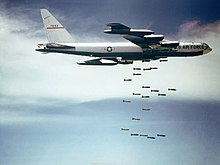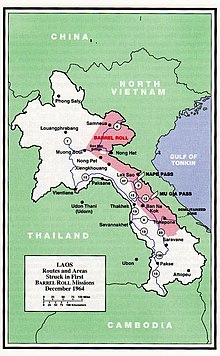Operation Barrel Roll


Operation Barrel Roll was the code name of a secret bombing campaign by the US Air Force in the Kingdom of Laos . The campaign started on December 14, 1964 and ended on March 29, 1973 .
The trigger for the campaign approved by President Lyndon B. Johnson was the attack by North Vietnamese and Pathet Lao units on the plains of the clay jugs held by Lao troops in northeast Laos, near the Vietnamese border. Pro-American units of the Lao government and the CIA supported Hmong -Rebellen should with close air support be saved from defeat. Another target of the bombing campaign was the strategically important Ho Chi Minh Trail , a network of roads and paths in the border area between Laos and Vietnam, which was used by North Vietnam to supply its armed forces and allies in South Vietnam. The campaign was primarily carried by fighter jets and strategic bombers based in Thailand . The campaign control center was in Udon Thani, northeastern Thailand . The campaign turned Laos into the most bombed area on earth.
history
Originally, the American government officially supported the Laotian government in the fight against the units of the communist Pathet Laos and North Vietnamese troops in the northeast of the country. The Military Assistance and Advisary Group Laos , MAAG Laos for short , was founded in the capital Vientiane for this purpose . After the signing of the Treaty on the Neutrality of Laos (English: International Agreement on the Neutrality of Laos), signed on July 23, 1962 in Geneva, the United States was not allowed to operate bases in Laos. MAAG Laos had to leave the country and moved to Bangkok, Laos, to the premises of the Joint US Military Advisory Group Thailand , JUSMAGTHAI for short, in Sathorn Tai Road next to the German embassy. However, a small camouflaged unit remained in Laos. This unit was called the Requirements Office and was officially run as a civilian institution of the United States Agency for International Development , USAID for short . The facility was officially under the control of the United States Ambassador to Laos. MAAG Laos was merged with MAAG Thailand and the unit was renamed Joint US Military Advisory Group Thailand. The Americans systematically expanded their troop presence, especially that of the Air Force in Thailand. Since direct military intervention in the Laotian civil war was no longer possible, the American foreign intelligence service CIA took over many of the MAAG Laos' tasks. The CIA recruited, paid and trained Laotian rebels to fight the Pathet Laos and North Vietnamese forces in northeast Laos. The JUSMAGTHAI continued to support the Laotian government, e.g. B. through the Waterpump project , a training program for Laotian pilots. JUSMAGTHAI also supported the Laotian government by providing military material, e.g. B. Fighter jets and ammunition. The North Vietnamese troops started their dry season offensive against these mercenary units of the CIA and the Laotian government troops in December 1964 . This operation was very successful and there was a risk that the king's seat in Luang Prabang could be overrun. To save the US allies from absolute defeat, Operation Barrel Roll was launched.
The operation was officially under the control of the US Embassy in Vientiane. This coordinated the attacks with the Lao government and the CIA. This often led to friction in the chain of command. US Ambassador William H. Sullivan was far from popular with the US military. There were particular problems with William W. Momyer, Commander in Chief of the Seventh Air Force . Operation Barrel Roll was not a high priority for the American Air Force after Operation Rolling Thunder began in May 1965 . Rolling Thunder bombed North Vietnam directly. And then there was Operation Steel Tiger against the Ho Chi Minh Trail and operations in South Vietnam. Sullivan called for additional air strikes on north-east Laos and for his own air fleet, which was directly under him, stationed in Nakhon Phanom, Thailand . Ambassador Sullivan often received air support only when bad weather prevented operations over Vietnam and the Ho Chi Minh Trail. On the other hand, Sullivan prevented or hindered ground-based operations by the American forces in Laos. He preferred to rely on CIA-backed paramilitaries.
The aim of Operation Barrel Roll was to support the allied land forces, i.e. the forces of the Lao government and the CIA-led Hmong rebels. In order to be able to carry out tactical air support, flight control officers , English Forward Air Controllers, or FAC for short , were required . At the beginning of the operation, T-28s of the Lao Air Force were used with an American co-pilot who had the task of piloting the American bombers. Aircraft from the CIA's own airline Air America were also used for this purpose. The flight control officers used the radio call sign Butterfly . But this solution did not satisfy the US Air Force leaders. General William W. Momyer in particular called for their own FAC units to be independent of the CIA. Therefore, on May 5, 1966, the Raven program was launched. The Raven program was based in Long Cheng, a Hmong rebel air force base. The Raven worked closely with the American embassy and with the commander of the Hmong Vang Pao .
The turning point came in 1968 for Operation Barrel Roll . Following the Tet Offensive , President Johnson ordered a partial stop in March and a complete stop to the bombing of North Vietnam in November. Now there was enough capacity. In 1966, an average of 20 bombing raids were carried out over Laos per day, this number reached 300 in 1969. But the North Vietnamese also systematically expanded their capacities in the area of the operational area and were thus successful. Among other things, they succeeded in eliminating the secret American military facility Lima Site 85 . In 1969, 80,000 regular North Vietnamese troops and 30,000 Pathet Laos units were operating in north-east Laos. In the past few years they only carried out offensives in the dry season, but thanks to improved transport routes they could now take the initiative all year round. In June 1969, in the middle of the rainy season, they conquered the plains of the clay jugs and attacked the headquarters of the Vang Pao troops. With the help of American bomber attacks, Vang Pao fought back with Operation About Face and completely retook the strategic plateau. But this win was a defeat for Vang Pao. He had lost his best troops to an opponent who could easily compensate for his losses. As early as 1968, a USAID representative found that Vang Pao's fighters were 30% 14-year-olds or younger (some even 10), 30% 15- or 16-year-olds, and 30% over 35-year-olds. The men in the intermediate age group are "all dead". In January 1970 the plain was again under the control of the North Vietnamese. All the air strikes of Operation Barrel Roll could not prevent this. In February 1970, B52 bombers were first deployed over the plains of the clay jars to relieve pressure on the Hmong headquarters. Vang Paos were also reinforced by troops from southern Laos and Thailand. But it wasn't until the use of gunships , heavily armed DC-3s and Lockheed AC-130s in March 1970 that the turning point was brought about. The North Vietnamese broke off their attacks on Long Cheng .
If the North Vietnamese had successfully ended the offensive, they could have reached Luang Prabang and Vientiane without any problems . The war in Laos would have lost its meaning. Thailand would most likely have withdrawn from its alliance with the Americans and retreated to defensive lines along the Mekong , the common border between Thailand and Laos. The US Air Force bases in Thailand would most likely have been lost. The operation thus became of decisive importance during the war.
Until 1970, Operation Barrel Roll could be kept secret from the public and the media. Reporters were denied access to the interior of the country and the bases in Thailand. The US Air Force only admitted armed reconnaissance flights over Laos, despite carrying out 50% of all bombing raids over Laos in 1969. On March 6, 1970, President Nixon first revealed the well-kept secret and admitted that American aircraft had been actively involved in the civil war in Laos.
In June 1971 Vang Pao tried again to recapture the level of the clay jugs, which he succeeded. But by December 1971 the strategic plane was already under control of North Vietnam again.
On January 27, 1973 , an armistice was agreed in Paris. That marked the end of Operation Barrel Roll . The last air raid was flown on April 17, 1973. CIA-run Air America stopped supporting the Hmong in mid- 1974 . Pathet Laos and North Vietnamese troops overran the Hmong Long Cheng headquarters in May 1975 . During the 9 years of operation, the US Air Force lost 131 aircraft. Most of the Hmong had to flee Laos after the war. Many emigrated to the USA, including Vang Pao. Others went into hiding in Thailand.
Individual evidence
- ↑ Martin Stuart-Fox Historical Dictionary of Laos, page 6
- ^ Operation Barrel Roll
- ↑ Jacob Van Staaveren Gradual Failure: The Air War Over North Vietnam, 1965-1966, page 64
- ↑ 1964 Operation Barrel Roll begins
- ^ Air Force Magazine Barrel Roll
- ^ Edgar "Pop" Buell, 1968. Quoted from: Anne Fadiman: The Spirit Catches You and You Fall Down. A Hmong Child, Her American Doctors, and the Collision of Two Cultures. Farrar, Straus & Giroux, New York 1997, p. 132.
- ↑ Martin Stuart-Fox Historical Dictionary of Laos, page 7

